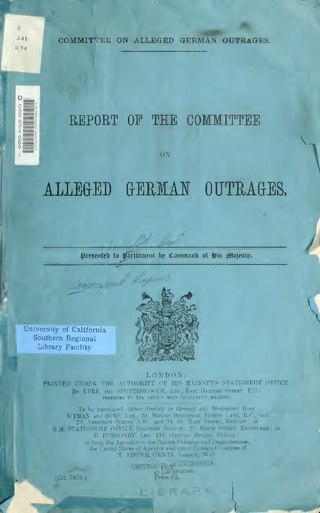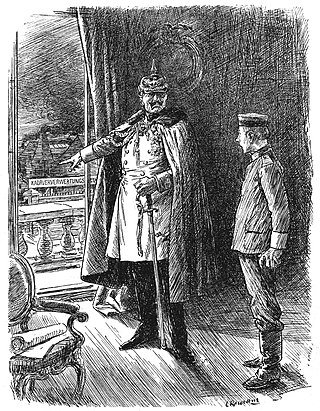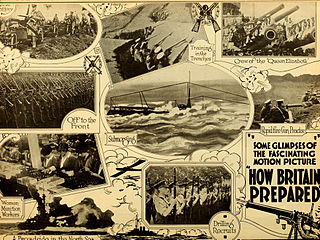
The "Deutschlandlied", officially titled "Das Lied der Deutschen", has been the national anthem of Germany either wholly or in part since 1922, except for a seven-year gap following World War II in West Germany. In East Germany, the national anthem was "Auferstanden aus Ruinen" between 1949 and 1990.

Propaganda is communication that is primarily used to influence or persuade an audience to further an agenda, which may not be objective and may be selectively presenting facts to encourage a particular synthesis or perception, or using loaded language to produce an emotional rather than a rational response to the information that is being presented. Propaganda can be found in a wide variety of different contexts.

Black propaganda is a form of propaganda intended to create the impression that it was created by those it is supposed to discredit. Black propaganda contrasts with gray propaganda, which does not identify its source, as well as white propaganda, which does not disguise its origins at all. It is typically used to vilify or embarrass the enemy through misrepresentation.
A big lie is a gross distortion or misrepresentation of the truth primarily used as a political propaganda technique. The German expression was first used by Adolf Hitler in his book Mein Kampf (1925) to describe how people could be induced to believe so colossal a lie because they would not believe that someone "could have the impudence to distort the truth so infamously". Hitler claimed that the technique had been used by Jews to blame Germany's loss in World War I on German general Erich Ludendorff, who was a prominent nationalist political leader in the Weimar Republic.

The Angels of Mons is one of several stories of the reputed appearance of a variety of supernatural entities which protected the British Army from defeat by the invading forces of the German Empire at the beginning of World War I during the Battle of Mons in Belgium on 23 August 1914.

Arthur Augustus William Harry Ponsonby, 1st Baron Ponsonby of Shulbrede, was a British politician, writer, and social activist. He was the son of Sir Henry Ponsonby, Private Secretary to Queen Victoria, and Mary Elizabeth Bulteel, daughter of John Crocker Bulteel. He was also the great-grandson of The 3rd Earl of Bessborough, The 3rd Earl of Bathurst and The 2nd Earl Grey. The 1st Baron Sysonby was his elder brother.

The propaganda used by the German Nazi Party in the years leading up to and during Adolf Hitler's dictatorship of Germany from 1933 to 1945 was a crucial instrument for acquiring and maintaining power, and for the implementation of Nazi policies.

The Rape of Belgium was a series of systematic war crimes, especially mass murder and deportation, by German troops against Belgian civilians during the invasion and occupation of Belgium in World War I.
The Union of Democratic Control was a British pressure group formed in 1914 to press for a more responsive foreign policy. While not a pacifist organisation, it was opposed to military influence in government.

The Committee on Alleged German Outrages, often called the Bryce Report after its chair, Viscount James Bryce (1838–1922), is best known for producing the "Report of the Committee on Alleged German Outrages," published on 12 May 1915. The report is seen as a major propaganda form that Britain used in order to influence international public opinion regarding the behaviour of Germany, which had invaded Belgium the year before. It was the first significant publication from the War Propaganda Bureau at Wellington House.

The German Corpse Factory or Kadaververwertungsanstalt, also sometimes called the "German Corpse-Rendering Works" or "Tallow Factory" was one of the most notorious anti-German atrocity propaganda stories circulated in World War I.

Britain re-created the World War I Ministry of Information for the duration of World War II to generate propaganda to influence the population towards support for the war effort. A wide range of media was employed aimed at local and overseas audiences. Traditional forms such as newspapers and posters were joined by new media including cinema (film), newsreels and radio. A wide range of themes were addressed, fostering hostility to the enemy, support for allies, and specific pro war projects such as conserving metal and growing vegetables.

The Crucified Soldier was the widespread story of an Allied soldier serving in the Canadian Corps who may have been crucified with bayonets on a barn door or a tree, while fighting on the Western Front during World War I. Three witnesses said they saw an unidentified crucified Canadian soldier near the battlefield of Ypres, Belgium, on or around 24 April 1915, but eyewitness accounts were somewhat contradictory, no crucified body was recovered and the identity of the crucified soldier was not discovered at the time.

In the First World War, British propaganda took various forms, including pictures, literature and film. Britain also placed significant emphasis on atrocity propaganda as a way of mobilising public opinion against Imperial Germany and the Central Powers during the First World War. For the global picture see Propaganda in World War I.

Anne Morelli is a Belgian historian of Italian origins, specialized in the history of religions and minorities. She is currently assistant director of the Interdisciplinary center for study of religion and secularism of the Université Libre de Bruxelles (ULB), where she is a teacher.
Atrocity propaganda is the spreading of information about the crimes committed by an enemy, which can be factual, but often includes or features deliberate fabrications or exaggerations. This can involve photographs, videos, illustrations, interviews, and other forms of information presentation or reporting.

World War I was the first war in which mass media and propaganda played a significant role in keeping the people at home informed on what occurred at the battlefields. It was also the first war in which governments systematically produced propaganda as a way to target the public and alter their opinion.

Propaganda is a form of communication that aims to shape people's beliefs and behaviors. It is typically not impartial and used to promote a specific agenda or perspective and is often biased, misleading, or even false. Propagandists use various techniques to manipulate people's opinions, including selective presentation of facts, the omission of relevant information, and the use of emotionally charged language.
The basic principles of war propaganda (Principes élémentaires de propagande de guerre) is a monograph by Anne Morelli published in 2001. It has not been translated into English. The subtitle recommends its "usability in case of cold, hot or lukewarm war".
Accusation in a mirror (AiM) is a technique where one falsely attributes to one's adversaries the intentions that one has for oneself and/or the actions that one is in the process of enacting. It has been cited, along with dehumanization, as one of the indirect or cloaked forms of incitement to genocide, which has contributed to the commission of genocide, for example in the Holocaust and the Rwandan genocide. By invoking collective self-defense, accusation in a mirror is used to justify genocide, just as self-defense is a defense for individual homicide.
















